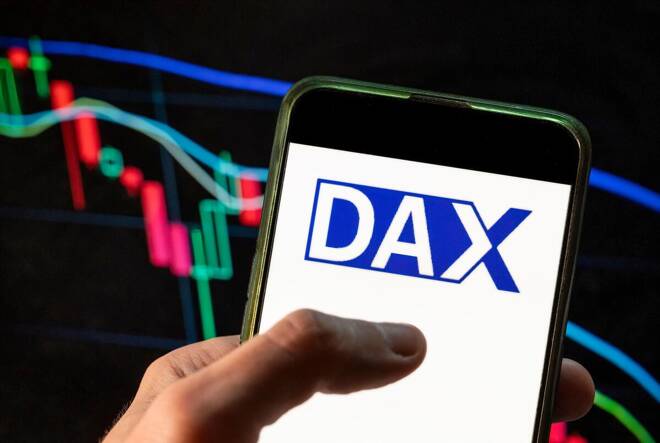Advertisement
Advertisement
DAX Index Today: Futures Slide After Asian Equity Market Rout
By:
Key Points:
- The DAX tumbled 2.30% on Thursday, August 1, ending the session at 18,083.
- US economic indicators and corporate earnings impacted buyer demand for DAX-listed stocks.
- On Friday, August 2, corporate earnings and the US Jobs Report require consideration.
In this article:
Market Overview
On Thursday, August 1, the DAX slid by 2.30%. Reversing a 0.53% gain from Wednesday, July 31, the DAX ended the session at 18,083.
Wednesday: DAX Market Movers
- Commerzbank and Deutsche Bank slid by 5.43% and 3.05%, respectively, as investors reacted to Soc Gen cutting its retail division outlook.
- BMW reported a lower-than-expected profit margin, impacting the auto sector.
- Volkswagen declined by 3.90%, while Daimler Truck Holding and BMW fell by 3.19% and 3.05%, respectively.
German Manufacturing Sector Contraction Deepens
On Thursday, finalized German manufacturing PMI numbers drew investor interest. The HCOB Manufacturing PMI fell from 43.5 in June to 43.2 in July, up from a preliminary 42.6.
Hamburg Commercial Bank Chief Economist Dr. Cyrus de la Rubia commented,
“Due to the sharp drop in production and new orders, we’re revising our growth forecast down. With manufacturing being so crucial to Germany’s economy (accounting for 22.6% of gross value added), we are now expecting the overall economy to grow by just 0.2% this year, down from our previous forecast of 0.5%.“
Corporate Earnings Remain a Focal Point
On Friday, August 2, Daimler Truck Holding will release earnings. Weaker-than-expected results and a gloomier outlook may further impact auto stocks.
US Continuing Jobless Claims Stoke Recession Fear
On Thursday, continuing jobless claims increased from 1,844k in the week ending July 13 to 1,877k in the ending July 20. The higher claims fueled speculation about a possible US hard landing.
The higher claims data followed Wednesday’s FOMC press conference, where Powell said he does not want further deterioration in the labor market.
US manufacturing sector data also signaled a waning US economy. The ISM Manufacturing PMI fell from 48.5 in June to 46.8 in July, stoking recession fears.
Expert Views on the US Labor Market
Arch Capital Global Chief Economist Parker Ross commented on the US labor market data, stating,
“With the latest data in hand, both initial and continuing claims remained in the gradual uptrend they have been in since the beginning of the year, although the latest weekly data showed a notable step higher above the recent non-COVID norm.”
US Market Trends
The US equity markets saw heavy losses on Thursday, August 1. The Nasdaq Composite Index tumbled 2.30%, while the Dow and the S&P 500 declined by 1.21% and 1.37%, respectively.
10-year US Treasury yields fell by 55 basis points to 3.978% on economic recession fears.
US Economic Data: The US Jobs Report
On Friday, the crucial US Jobs Report will put the US economy under the spotlight.
Economists forecast average hourly earnings to increase by 3.7% year-on-year in July, down from 3.9% in June.
Softer-than-expected wage growth could reduce disposable income, impacting consumer spending and the US economy. Private consumption accounts for over 60% of the US economy.
Additionally, an unexpected rise in the US unemployment rate from 4.1% in June could spook investors.
Weaker labor market conditions would support a more dovish Fed rate path. However, fears of an economic recession could overshadow lower borrowing costs and impact buyer demand for riskier assets.
Other Stats
Other stats include US factory orders. However, these will likely play second fiddle to the US Jobs Report.
Near-Term Outlook
Near-term DAX trends depend on corporate earnings and the US Jobs Report. Weaker US labor market data and disappointing corporate earnings could drag the DAX toward 17,850. Geopolitical tensions in the Middle East also need consideration.
In the futures markets, the DAX and the Nasdaq mini were down by 103 and 239 points, respectively. The Asian market session, with the Nikkei Index tumbling 5.03%, will likely set the tone for Friday’s European session.
Investors should remain vigilant with corporate earnings, the US Jobs Report, and the Middle East in focus. Monitor the news wires, economic data, and expert commentary to manage trading strategies. Stay up-to-date with our latest news and analysis to manage risk.
DAX Technical Indicators
Daily Chart
The DAX sat below the 50-day EMA while holding above the 200-day EMA, sending bearish near-term but bullish longer-term price signals.
A return to 18,250 would support a move toward the 50-day EMA. A Breakout from the 50-day EMA would bring 18,500 into play.
Corporate earnings, the US Jobs Report, and geopolitics require consideration.
Conversely, a DAX drop below 18,000 could give the bears a run at the 17,615 support level and the 200-day EMA.
The 14-day RSI at 42.14 suggests a DAX drop to the 17,615 support level before entering oversold territory.
4-Hourly Chart
The DAX sat below the 50-day and 200-day EMAs, affirming the bearish near-term price signals.
A break above the 200-day EMA would support a move toward the 50-day EMA and the 18,500 handle.
However, a DAX drop below 18,000 could give the bears a run at 17,850.
The 14-period 4-hour RSI at 35.22 suggests a DAX drop below 18,000 before entering oversold territory.
About the Author
Bob Masonauthor
With over 20 years of experience in the finance industry, Bob has been managing regional teams across Europe and Asia and focusing on analytics across both corporate and financial institutions. Currently he is covering developments relating to the financial markets, including currencies, commodities, alternative asset classes, and global equities.
Latest news and analysis
Advertisement
